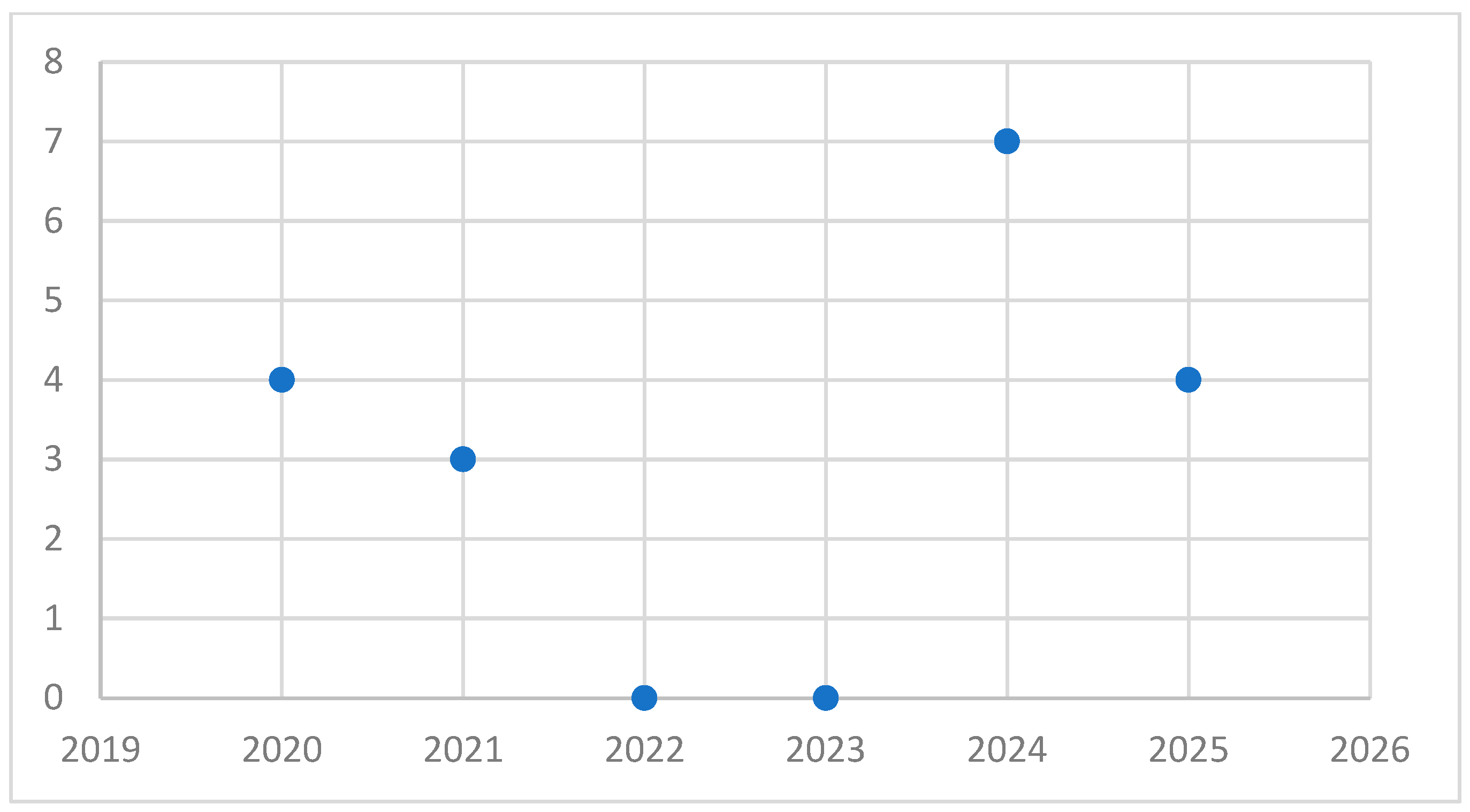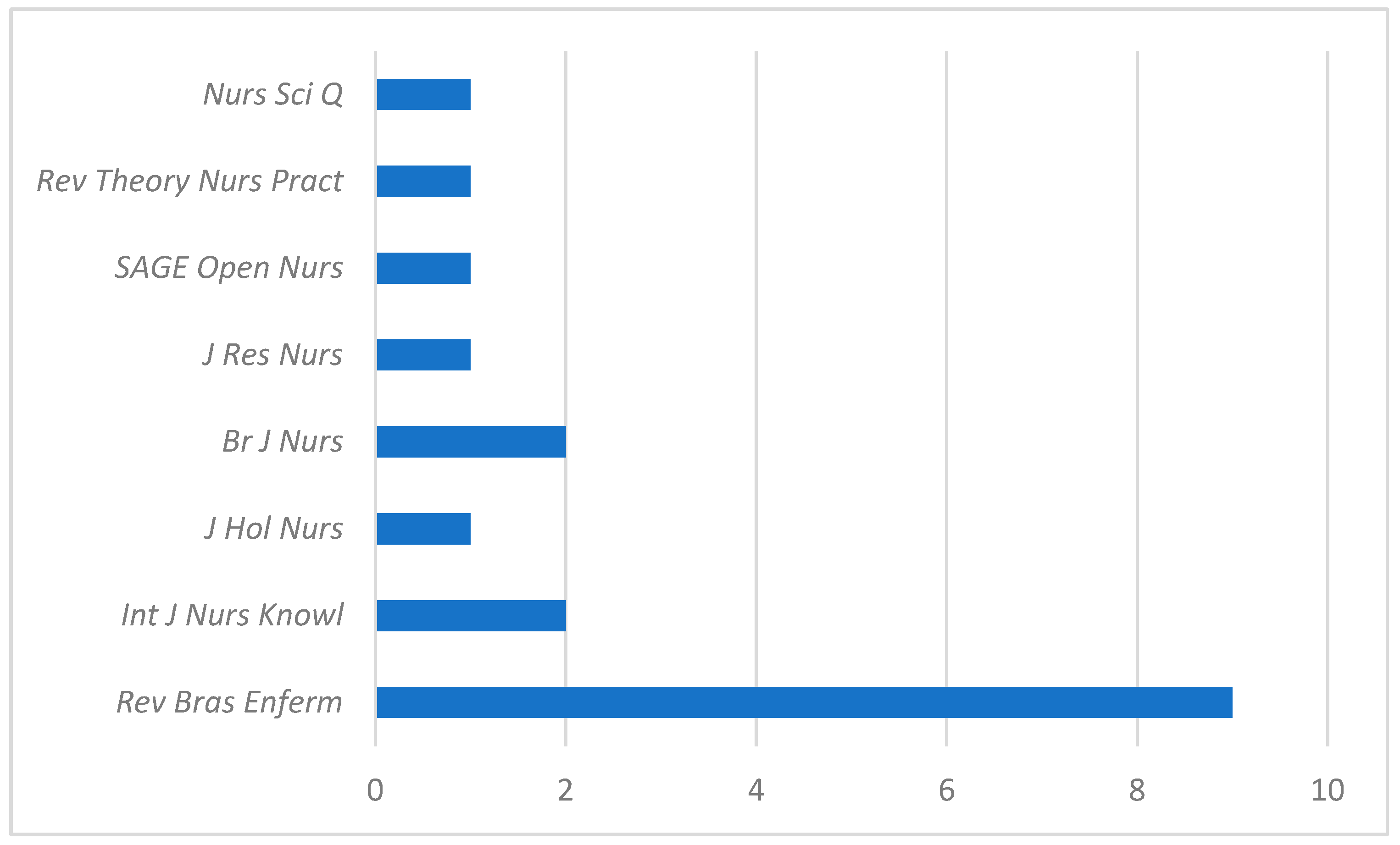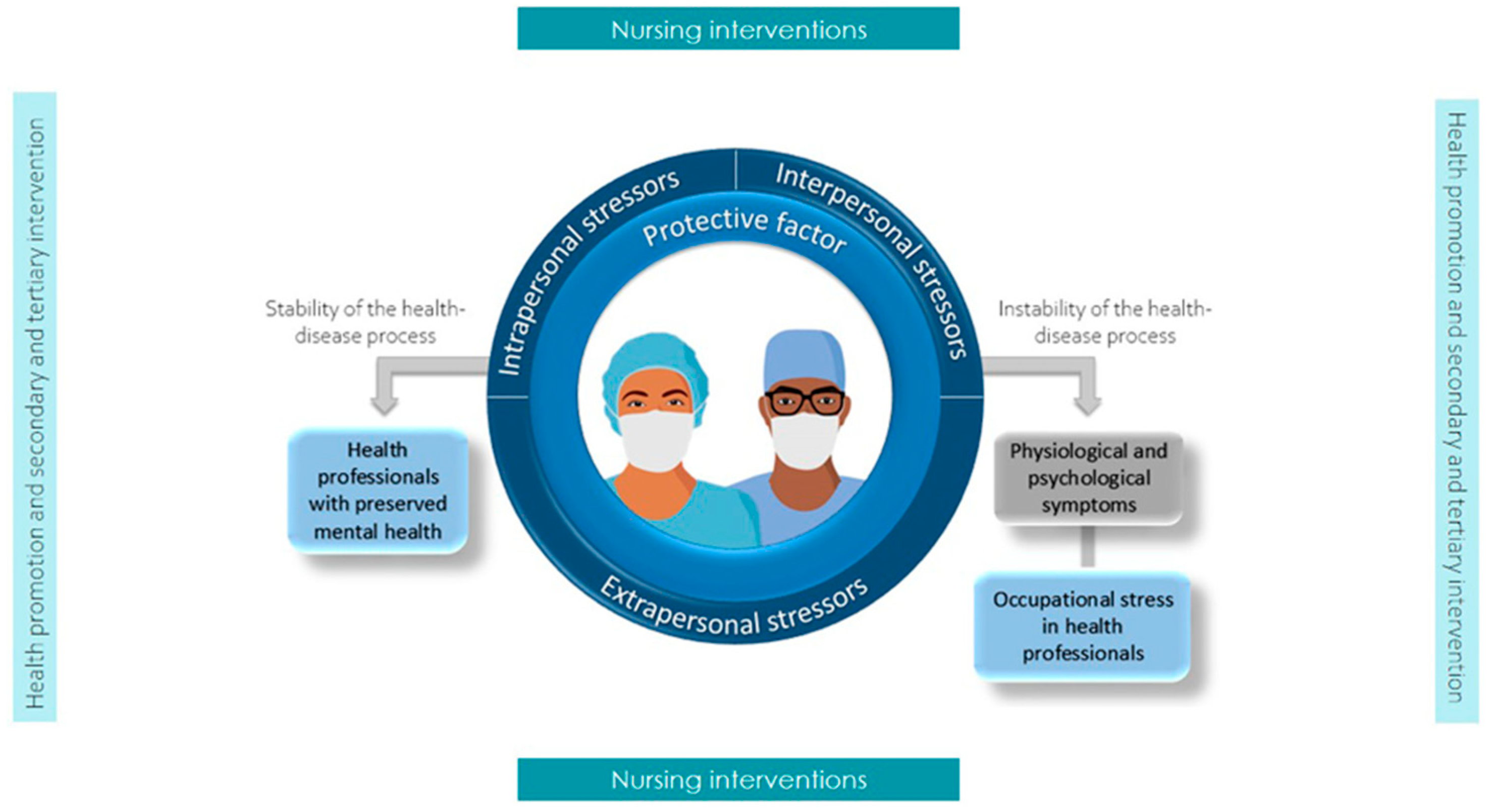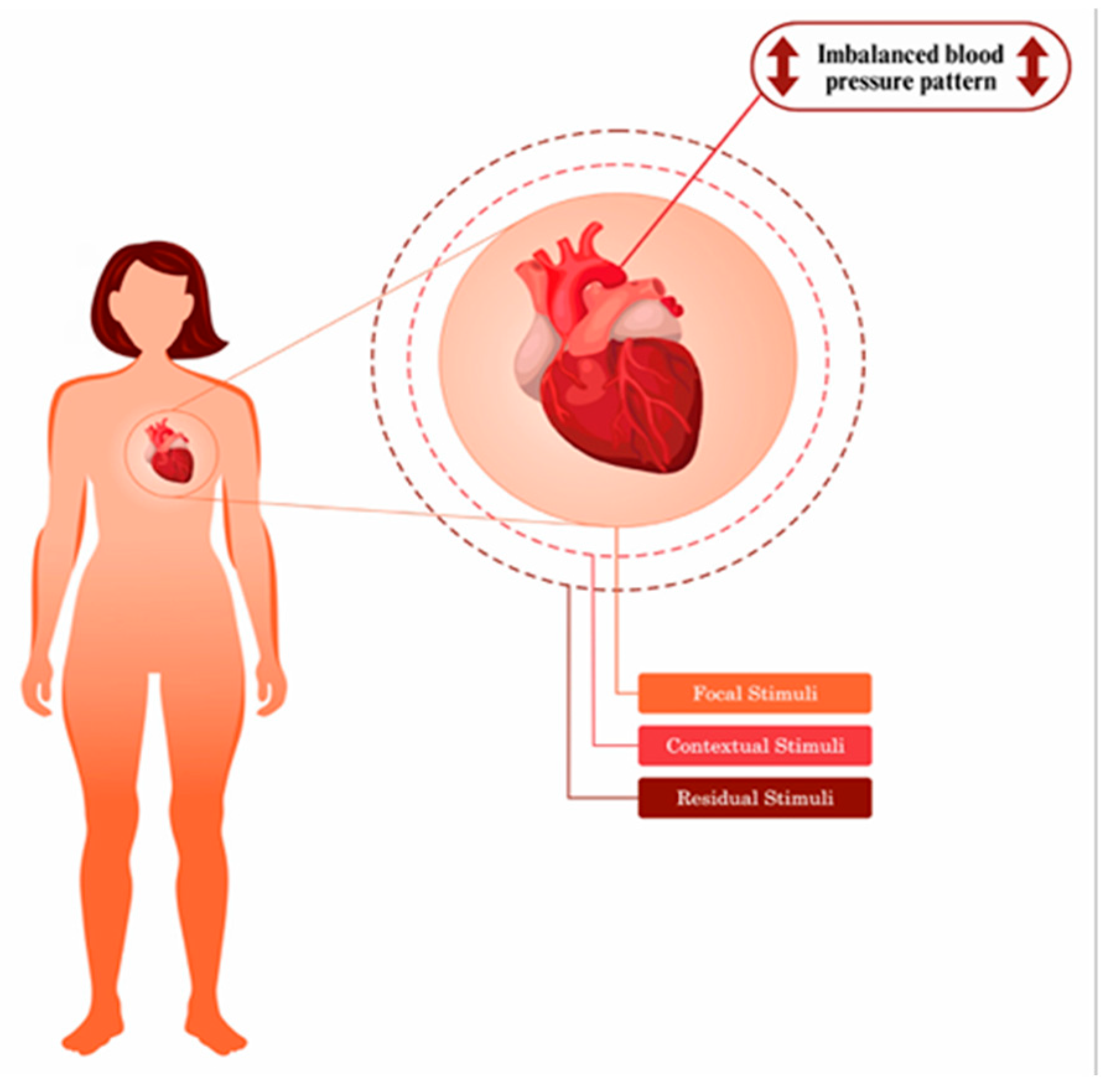Emerging Trends in Mid-Range Nursing Theories: A Scoping Review
Abstract
1. Introduction
1.1. Stage I (1977–1990): The Onset of Clinical Research and Theoretical Development [1]
1.2. Stage II (1990–2000): The Rise in Evidence-Based Research [2]
1.3. Stage III (2000–2010): Globalization of Research and Multidisciplinary Approaches [3]
1.4. Stage IV (2010–Nowadays): Advanced Practice Nursing and Contemporary Challenges [4]
1.5. Mid-Range Nurse Theories in Nursing (MRNT)
- (a)
- How many MRNT have been published in nursing over the last 5 years?
- (b)
- Which fields or topics are most frequently addressed within these theories?
- (c)
- What current trends characterize research on MRNTs?
2. Materials and Methods
2.1. Design
2.2. Eligibility Criteria
2.3. Search Strategy and Information Sources
2.4. Data Extraction Process
2.5. Critical Appraisal
2.6. Data Analysis and Synthesis of Results
3. Results
Characteristics of Sources of Evidence
4. Discussion
4.1. Limitations
4.2. Future Directions
5. Conclusions
Author Contributions
Funding
Institutional Review Board Statement
Informed Consent Statement
Data Availability Statement
Public Involvement Statement
Guidelines and Standards Statement
Use of Artificial Intelligence
Acknowledgments
Conflicts of Interest
References
- D’Egidio, M.; Pires, D. A pesquisa em enfermagem no Brasil e a produção do conhecimento: Um panorama de 1970 a 2019. Rev. Lat. Enferm. 2020, 56, 6. [Google Scholar] [CrossRef]
- López-Medina, I.; Sampedro-Mérida, I.M.; Hernández-López, J.L. Tendencias de investigación en enfermería: Un estudio bibliométrico en la base de datos Scopus. Enferm. Glob. 2019, 18, 350–368. [Google Scholar]
- Alcalá-Albert, G.J.; Parra-González, M.E. Bibliometric Analysis of Scientific Production on Nursing Research in the Web of Science. Educ. Sci. 2021, 11, 455. [Google Scholar] [CrossRef]
- Monaco, F.; Andretta, V.; Bellocchio, U.; Cerrone, V.; Cascella, M.; Piazza, O. Bibliometric Analysis (2000–2024) of Research on Artificial Intelligence in Nursing. Adv. Nurs. Sci. 2025, 48, 228–239. [Google Scholar] [CrossRef]
- Muñoz, L. Nursing theories visibility in the discipline’s scientific publications. Aquichan 2024, 24, e2411. [Google Scholar] [CrossRef]
- Connor, L.; Dean, J.; McNett, M.; Tydings, D.M.; Shrout, A.; Gorsuch, P.F.; Hole, A.; Moore, L.; Brown, R.; Melnyk, B.M.; et al. Evidence-based practice improves patient outcomes and healthcare system return on investment: Findings from a scoping review. Worldviews Evid. Based Nurs. 2023, 20, 6–15. [Google Scholar] [CrossRef] [PubMed]
- Peterson, S.J.; Bredow, T.S. Middle Range Theories: Application to Nursing Research, 3rd ed.; Wolters Kluwer Health/Lippincott Williams & Wilkins: Philadelphia, PA, USA, 2013. [Google Scholar]
- Grace, P.J.; Willis, D.G.; Roy, C.; Jones, D. Profession at the crossroads: A dialogue concerning the preparation of nursing scholars and leaders. Nurs. Outlook. 2016, 64, 61–70. [Google Scholar] [CrossRef] [PubMed]
- Manhart, E. Again, what is nursing science? Nurs. Sci. Q. 2017, 30, 128–133. [Google Scholar] [CrossRef]
- Yancey, N. Why teach nursing theory? Nurs. Sci. Q. 2015, 28, 274–278. [Google Scholar] [CrossRef]
- Gardner, H. Five Minds for the Future; Harvard Business School Press: Boston, MA, USA, 2006. [Google Scholar]
- Nelson, J.W. A future without nursing conceptual frameworks. Int. J. Hum. Caring 2017, 21, 53. [Google Scholar] [CrossRef]
- American Association of Colleges of Nursing. The Essentials of Doctoral Education for Advanced Nursing Practice. 2006. Available online: https://www.aacnnursing.org/Portals/42/Publications/DNPEssentials.pdf (accessed on 15 August 2025).
- Fawcett, J. Analyzing Conceptual Models of Nursing; Springer: New York, NY, USA, 2017. [Google Scholar]
- Leandro, T.A.; Nunes, M.M.; Teixeira, I.X.; Lopes, M.V.d.O.; de Araújo, T.L.; Lima, F.E.T.; da Silva, V.M. Development of middle-range theories in nursing. Rev. Bras. Enferm. 2020, 73, e20170893. [Google Scholar] [CrossRef]
- Tricco, A.C.; Lillie, E.; Zarin, W.; O’Brien, K.K.; Colquhoun, H.; Levac, D.; Moher, D.; Peters, M.D.J.; Horsley, T.; Weeks, L.; et al. PRISMA extension for scoping reviews (PRISMA-ScR): Checklist and explanation. Ann. Intern. Med. 2018, 169, 467. [Google Scholar] [CrossRef] [PubMed]
- Arksey, H.; O’Malley, L. Scoping studies: Towards a methodological framework. Int. J. Soc. Res. Methodol. 2005, 8, 19–32. [Google Scholar] [CrossRef]
- Anderson, S.; Allen, P.; Peckham, S.; Goodwin, N. Asking the right questions: Scoping studies in the commissioning of research on the organization and delivery of health services. Health Res. Policy Syst. 2008, 6, 12. [Google Scholar] [CrossRef]
- Ehrich, K.; Freeman, G.K.; Richards, S.C.; Robinson, I.C.; Shepperd, S. How to do a scoping exercise: Continuity of care. Res. Pol. Plan. 2002, 20, 25–29. [Google Scholar]
- Peters, M.D.; Godfrey, C.M.; Khalil, H.; McInerney, P.; Parker, D.; Soares, C.B. Guidance for conducting systematic scoping reviews. Int. J. Evid. Based Healthc. 2015, 13, 141–146. [Google Scholar] [CrossRef]
- Clarivate. Journal Citation Reports; Clarivate: Philadelphia, PA, USA, 2025; Available online: https://clarivate.com/products/scientific-and-academic-research/research-analytics-evaluation-and-management-solutions/journal-citation-reports/ (accessed on 20 October 2025).
- Moher, D.; Liberati, A.; Tetzlaff, J.; Altman, D.G. Preferred reporting items for systematic reviews and meta-analyses: The PRISMA statement. Ann. Intern. Med. 2009, 151, 264–269. [Google Scholar] [CrossRef] [PubMed]
- Godfrey, C.M.; Harrison, M.B.; Lang, A.; Macdonald, M.; Leung, T.; Swab, M. Homecare safety and medication management with older adults: A scoping review of the quantitative and qualitative evidence. JBI Database Syst. Rev. Implement. Rep. 2013, 11, 82–130. [Google Scholar] [CrossRef]
- Aromataris, E.; Fernandez, R.; Godfrey, C.; Holly, C.; Kahlil, H.; Tungpunkom, P. Summarizing systematic reviews: Methodological development, conduct and reporting of an umbrella review approach. Int. J. Evid. Based Healthc. 2015, 13, 132–140. [Google Scholar] [CrossRef] [PubMed]
- Ouzzani, M.; Hammady, H.; Fedorowicz, Z.; Elmagarmid, A. Rayyan—A web and mobile app for systematic reviews. Syst. Rev. 2016, 5, 210. [Google Scholar] [CrossRef]
- Microsoft Corporation. Excel; Microsoft Corporation: Redmond, VA, USA, 2016. [Google Scholar]
- Peters, M.D.J.; Godfrey, C.; McInerney, P.; Munn, Z.; Tricco, A.C.; Khalil, H. Scoping Reviews (2020 Version); Aromataris, E., Lockwood, C., Porritt, K., Pilla, B., Jordan, Z., Eds.; JBI Manual for Evidence Synthesis; JBI: Adelaide, Australia, 2024; ISBN 978-0-6488488-0-6. [Google Scholar]
- Barreiro, R.G.; Lopes, M.V.O.; Cavalcante, L.P. Middle-range theory for the nursing diagnosis of low self-efficacy in health. Rev. Bras. Enferm. 2020, 73, e20190370. [Google Scholar] [CrossRef]
- Bandura, A. Social Foundations of Thought and Action: A Social Cognitive Theory; Prentice-Hall: Englewood Cliffs, NJ, USA, 1986. [Google Scholar]
- Fróes, N.B.M.; Lopes, M.V.O.; Pontes, C.M.; Ferreira, G.L.; Aquino, P.S. Middle range theory for the nursing diagnosis excess fluid volume in pregnant women. Rev. Bras. Enferm. 2020, 73, e20190334. [Google Scholar] [CrossRef]
- Paul, J.C. Development of the middle-range theory of wound itch. Br. J. Nurs. 2020, 29, S32–S37. [Google Scholar] [CrossRef]
- Levine, M.E. The four conservation principles of nursing. Nurs. Forum 1967, 6, 45–59. [Google Scholar] [CrossRef]
- Attaallah, S.A.; Peters, R.M.; Benkert, R.; Yarandi, H.; Oliver-McNeil, S.; Hopp, F. Developing a middle-range theory of heart failure self-care. Nurs. Sci. Q. 2021, 34, 168–177. [Google Scholar] [CrossRef]
- Orem, D.E. Nursing: Concepts of Practice, 6th ed.; Mosby Year Book: St. Louis, MO, USA, 2001. [Google Scholar]
- Silva, C.G.D.; Araújo, S.S.; Morais, S.C.R.V.; Frazão, C.M.F.Q. Impaired knowledge in individuals with heart failure: A middle range nursing theory. Rev. Bras. Enferm. 2021, 75, e20200855. [Google Scholar] [CrossRef] [PubMed]
- Almino, R.H.S.C.; Pereira da Silva, A.B.; Dantas, A.L.M.; de Menezes, H.F.; Prado, N.C.d.C.; Santos, R.S.d.C.; Manso, R.K.G.d.S.; Ferreira, T.T.; da Silva, R.A.R. Middle-range theory of occupational stress in health professionals. SAGE Open Nurs. 2024, 10, 23779608241236290. [Google Scholar] [CrossRef] [PubMed]
- Silva, G.P.D.; Lopes, C.T.; Lopes, M.V.O.; Mendes, R.C.M.G.; Perrelli, J.G.A.; Pascoal, L.M.; Mangueira, S.d.O.; Linhares, F.M.P. Risk for imbalanced blood pressure pattern among incarcerated women: Middle-range theory. Rev. Bras. Enferm. 2024, 77, e20230288. [Google Scholar] [CrossRef]
- Félix, N.D.C.; Barros, A.L.B.L.; Nóbrega, M.M.L.D. Middle-range theory for nursing for care in the context of cardiovascular risk. Rev. Bras. Enferm. 2024, 77, e20240190. [Google Scholar] [CrossRef]
- Fernandes, R.M.; Carino, A.C.C.; Almeida, A.T.D.; Fernandes, M.I.d.C.D.; Leopoldino, S.K.d.M.; Gomes, C.S.T.; Nelson, A.R.C.; Lira, A.L.B.d.C. Middle-range theory of the nursing diagnosis of sedentary lifestyle in young adults. Rev. Bras. Enferm. 2024, 77, e20230516. [Google Scholar] [PubMed]
- Roy, C. The Roy Adaptation Model, 3rd ed.; Pearson Education: Hoboken, NJ, USA, 2009. [Google Scholar]
- Carino, A.C.C.; Fernandes, R.M.; Almeida, A.T.D.; Frazão, C.M.F.Q.; Kluczynik, C.E.N.; Lira, A.L.B.C. Mid-range theory of the nursing diagnosis overweight. Rev. Bras. Enferm. 2024, 77, e20230372. [Google Scholar] [CrossRef]
- Tonin, L.; Lacerda, M.R.; Diogo, P.M.J.; Brandão, M.A.G.; Wall, M.L.; Vale, P.R.L.F.D. Construction of a middle-range nursing theory for transpersonal home care. Rev. Bras. Enferm. 2025, 78, e20240200. [Google Scholar] [CrossRef]
- Watson, J. Clarifying the discipline of nursing as foundational to development of professional nursing. Texto Contexto Enferm. 2017, 26, 1–2. [Google Scholar] [CrossRef]
- de França, M.S.; Linhares, F.M.P.; Gomes Mendes, R.C.M.; de Oliveira Lopes, M.V.; de Queiroz Frazão, C.M.F.; de Maria Alves de Sousa, S.; Pontes, C.M. Middle range theory for the nursing phenomenon ineffective social support network. Int. J. Nurs. Knowl. 2024, 35, 375–383. [Google Scholar] [CrossRef] [PubMed]
- Brittain, A.C.; Carrington, J.M. Advancing nursing science: Deriving a middle-range theory for system-level communication research in complex hospital environments. Res. Theory Nurs. Pract. 2024, 38, 152–170. [Google Scholar] [CrossRef] [PubMed]
- Lemos, L.A.; Cavalcante, L.P.; Lopes, M.V.O. Middle range theory for the nursing diagnosis of dysfunctional ventilatory weaning response. Int. J. Nurs. Knowl. 2020, 31, 253–259. [Google Scholar] [CrossRef] [PubMed]
- Silva, L.F.M.D.; Pascoal, L.M.; Lima, F.E.T.; Santos, F.S.; Santos Neto, M.; Brito, P.D.S. Ineffective peripheral tissue perfusion in patients with diabetic foot: A mid-range theory. Rev. Bras. Enferm. 2021, 74, e20210113. [Google Scholar] [CrossRef]
- Rivera, D.; Jukkala, A.; Rohini, T. Introduction to Rivera’s Gender Affirming Nursing Care Model: A Middle-Range Theory. J. Holist. Nurs. 2022, 40, 255–264. [Google Scholar] [CrossRef]
- McCance, T.; McCormack, B. The Person-centred Nursing Framework: A mid-range theory for nursing practice. J. Res. Nurs. 2025, 13, 47–60. [Google Scholar] [CrossRef]
- Costa, R.S.D.; Menezes, H.F.; Prado, N.C.D.C.; Pereira, A.B.; Ferreira, T.T.; Holanda, J.R.R.; da Silva, R.A.R. The middle-range theory of the nursing diagnosis “ineffective health self-management”. Rev. Bras. Enferm. 2025, 78, e20240470. [Google Scholar] [CrossRef]
- Page, M.J.; McKenzie, J.E.; Bossuyt, P.M.; Boutron, I.; Hoffmann, T.C.; Mulrow, C.D.; Shamseer, L.; Tetzlaff, J.M.; Akl, E.A.; Brennan, S.E.; et al. The PRISMA 2020 statement: An updated guideline for reporting systematic reviews. BMJ 2021, 372, n71. [Google Scholar] [CrossRef]
- Muñoz, M.S. Competencias en Práctica Clínica Basada en la Evidencia de las Enfermeras en España; Universidad Complutense de Madrid: Madrid, Spain, 2015. [Google Scholar]
- Zhu, R.; Liu, M.; Su, Y.; Meng, X.; Han, S.; Duan, Z. A bibliometric analysis of publication of funded studies in nursing research from Web of Science, 2008–2018. J. Adv. Nurs. 2021, 77, 176–188. [Google Scholar] [CrossRef] [PubMed]
- Nwozichi, C.U.; Olorunfemi, O.; Madu, A.M. Exploring issues in theory development in nursing: Insights from literature. Indian J. Contin. Nurs. Educ. 2021, 22, 3–9. [Google Scholar] [CrossRef]
- Cardoso, R.B.; Brandão, M.A.G.; Cavalcante, J.C.S.D.S.; Lopes, R.O.P.; Zaccaro, K.R.L.; Primo, C.C. Brazilian nursing specific situation, middle and micro-range theories: A bibliometric study. Rev. Bras. Enferm. 2024, 77, e20230520. [Google Scholar] [CrossRef]
- Bahramnezhad, F.; Shiri, M.; Asgari, P.; Afshar, P.F. A review of the nursing paradigm. Open J. Nurs. 2015, 5, 17. [Google Scholar] [CrossRef]
- Brand, A.; Allen, L.; Altman, M.; Hlava, M.; Scott, J. Beyond Authorship: Attribution, Contribution, Collaboration, and Credit. Learn. Publ. 2015, 28, 151–155. [Google Scholar] [CrossRef]






| Title | Authors | Journal | Main Findings |
|---|---|---|---|
| Middle-Range Theory for the Nursing Diagnosis of Low Health Self-Efficacy [28,29] | Barreiro et al. | Rev Bras Enferm 4 | The key concepts underlying the new nursing diagnosis of low health self-efficacy were identified and defined. |
| Middle-Range Theory for the Nursing Diagnosis of Excessive Fluid Volume in Pregnant Women [30] | Fróes et al. | Rev Bras Enferm 4 | Incorporated physiological and pathological factors to explain excessive fluid volume, improving understanding of causal factors and clinical indicators. |
| Development of the Middle-Range Theory of Wound Pruritus [31,32] | Paul J. | Br J Nurs 2 | Outlined the development of the wound pruritus theory based on Levine’s conservation model, integrating its concepts and propositions. |
| Development of a Middle-Range Theory of Heart Failure Self-Care [33,34] | Attallah et al. | Nurs Sci Q 8 | Described the strategy for constructing a middle-range theory addressing self-care in heart failure. |
| Impaired Knowledge in Individuals with Heart Failure: A Middle-Range Nursing Theory [35] | Da Silva, et al. | Rev Bras Enferm 4 | Provided a framework to guide nurses’ clinical judgment regarding knowledge deterioration in heart failure, supporting individualized interventions to improve quality of life. |
| Middle-Range Theory of Occupational Stress in Health Professionals [36] | Costa et al. | SAGE Open Nurs 6 | Supported the development of elements for proposing a nursing diagnosis of occupational stress, strengthening diagnostic reasoning and guiding preventive interventions. |
| Risk for Imbalanced Blood Pressure Pattern among Incarcerated Women: Middle-Range Theory [37] | Da Silva et al. | Rev Bras Enferm 4 | Provided a theoretical basis for understanding the risk of imbalanced blood pressure in incarcerated women, aiding in planning cardiovascular health interventions. |
| Middle-Range Theory for Nursing Care in the Context of Cardiovascular Risk [38] | Félix et al. | Rev Bras Enferm 4 | Contributed to developing knowledge that supports nursing care planning for individuals at cardiovascular risk. |
| Middle-Range Theory of the Nursing Diagnosis of Sedentary Lifestyle in Young Adults [39,40] | Fernandes et al. | Rev Bras Enferm 4 | Identified determinants of sedentary lifestyle in young adults to support evidence-based nursing interventions. |
| Middle-Range Theory of the Nursing Diagnosis: Overweight [41] | Costa et al. | Rev Bras Enferm 4 | Enhanced understanding of the nursing diagnosis of overweight in adolescents and young adults by identifying causal and predisposing factors. |
| Construction of a Middle-Range Nursing Theory for Transpersonal Home Care [42,43] | Tonin et al. | Rev Bras Enferm 4 | Developed a theoretical model for home care addressing physiological, psychological, sociocultural, developmental, and spiritual needs; pending empirical validation. |
| Middle-Range Theory for the Nursing Phenomenon of Ineffective Social Support Networks [44] | De França et al. | Int J Nurs Knowl 5 | Provided an understanding of individuals from an interpersonal perspective, highlighting how networks of virtues and vices influence health outcomes negatively. |
| Advancing Nursing Science: Deriving a Middle-Range Theory for System-Level Communication Research in Complex Hospital Environments [45] | Brittain et al. | Rev Theory Nurs Pract 7 | Addressed the need to optimize healthcare communication research through robust theoretical frameworks, emphasizing the complexity of hospital settings. |
| Middle-Range Theory for the Nursing Diagnosis of Dysfunctional Ventilatory Weaning Response [46] | Lemo et al. | Int J Nurs Knowl 5 | Applied utility theory to nursing care during the ventilatory weaning process to enhance clinical decision-making. |
| Middle-Range Theory on Ineffective Peripheral Tissue Perfusion in Patients with Diabetic Foot [47] | Moraes et al. | Rev Bras Enferm 4 | Expanded conceptual understanding and demonstrated causal relationships among factors involved in ineffective peripheral tissue perfusion. |
| Introduction to Rivera’s Gender Affirming Nursing Care Model: A Middle-Range Theory [48] | Rivera D., et al. | J Holist Nurs 1 | Introduced a framework integrating relationship, knowledge, and commitment domains to guide gender-affirming nursing care practices |
| The Person-Centered Nursing Framework: A Middle-Range Theory for Nursing Practice [49] | McCance et al. | J Res Nurs 3 | Highlights the contextual, attitudinal, and moral dimensions of humanitarian nursing care practices. |
| Middle-Range Theory of the Nursing Diagnosis “Ineffective Health Self-Management” [50] | Costa et al. | Rev Bras Enferm 4 | Provides a framework for nurses to make clinical judgments regarding the diagnosis of ineffective health self-management among individuals living with HIV. |
Disclaimer/Publisher’s Note: The statements, opinions and data contained in all publications are solely those of the individual author(s) and contributor(s) and not of MDPI and/or the editor(s). MDPI and/or the editor(s) disclaim responsibility for any injury to people or property resulting from any ideas, methods, instructions or products referred to in the content. |
© 2025 by the authors. Licensee MDPI, Basel, Switzerland. This article is an open access article distributed under the terms and conditions of the Creative Commons Attribution (CC BY) license (https://creativecommons.org/licenses/by/4.0/).
Share and Cite
Sancho-Cantus, D.; Escrivá-Peiró, D.; Cunha-Pérez, C. Emerging Trends in Mid-Range Nursing Theories: A Scoping Review. Nurs. Rep. 2025, 15, 382. https://doi.org/10.3390/nursrep15110382
Sancho-Cantus D, Escrivá-Peiró D, Cunha-Pérez C. Emerging Trends in Mid-Range Nursing Theories: A Scoping Review. Nursing Reports. 2025; 15(11):382. https://doi.org/10.3390/nursrep15110382
Chicago/Turabian StyleSancho-Cantus, David, Dolores Escrivá-Peiró, and Cristina Cunha-Pérez. 2025. "Emerging Trends in Mid-Range Nursing Theories: A Scoping Review" Nursing Reports 15, no. 11: 382. https://doi.org/10.3390/nursrep15110382
APA StyleSancho-Cantus, D., Escrivá-Peiró, D., & Cunha-Pérez, C. (2025). Emerging Trends in Mid-Range Nursing Theories: A Scoping Review. Nursing Reports, 15(11), 382. https://doi.org/10.3390/nursrep15110382







